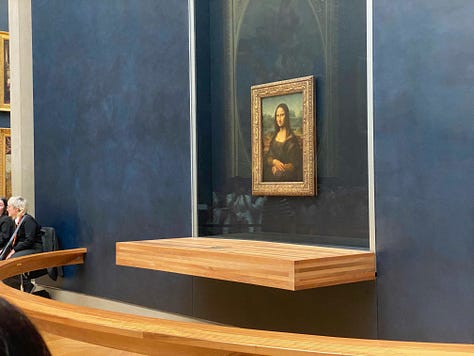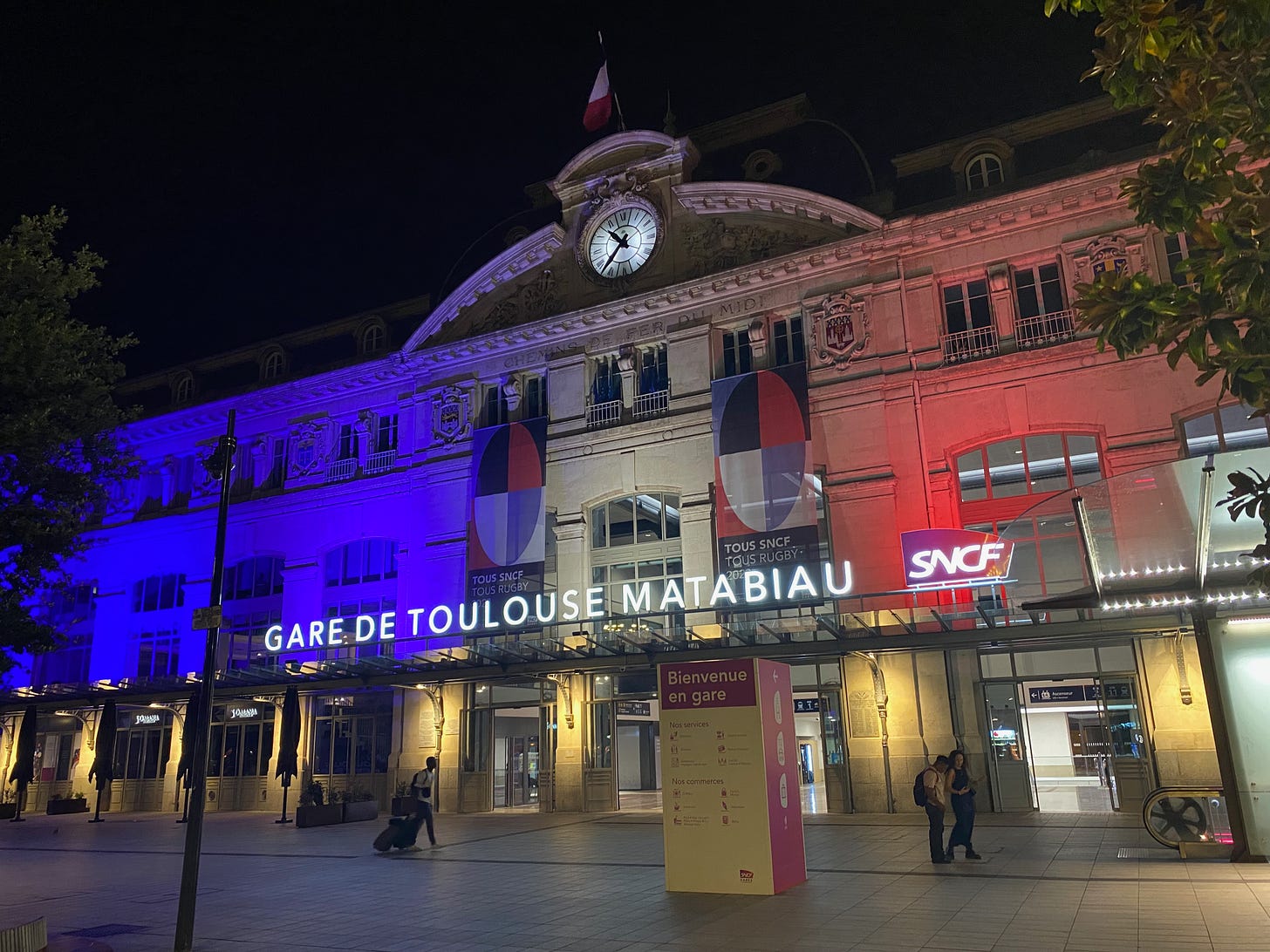Toodaloo, Toulouse
My last days in the Ville Rose are marked by airplanes, art, torture and, of course, the Canal du Midi
I am on the road again after a lengthy layover in Toulouse. Destination: Sevilla and the Andalusia region of Spain. I’ve heard so much positive chatter about Andalusia, from Spaniards and everyone else, that I have added it to my French itinerary despite it not being very… français.
I’ll have more to share in future posts; today’s will instead be my farewell to Toulouse, which had been my home base, or pied-à-terre, since arriving in Europe last September.
I’ve done and seen a lot here since the fall, and I’ve ticked a lot of the typical tourist boxes. I’ve also done a lot of walking around the winding alleys and broad boulevards of old Toulouse, enjoying the mix of modernity and medieval, and the great care the city has taken to ensure it remains a safe, walkable, clean and well-maintained attraction for residents and visitors alike. A case in point is the promenade along the Garonne River, which not only attracts thousands of visitors both above and below the towering dike walls on both shores, but is a masterpiece of urban lighting that allows for post-card quality images from even the simplest of cameras.









Forget the disco lights of Montréal’s Champlain and Jacques-Cartier bridges, Toulouse’s lights subtly highlight the natural pastels of “La Ville Rose,” so called because of the pinkish terracotta that dominates the brickwork of so much of the ancient structures. It’s a tradition that has been maintained despite the availability of much more colourful modern construction materials, not just in the old town but even in new constructions that have popped up like mushrooms in the urban outskirts thanks to the growth of the region’s largest employer, Airbus.
I had hoped to complete my to-do list of the city’s many attractions during my last two weeks in Toulouse, but, as I wrote last week, I was instead waylaid by a man-cold. Combined with unseasonal rainy and chilly weather, my ambitions were thwarted, but I still managed to take a walking tour of the city and visited the Montagne Noire site of the dam and massive reservoir that gave life to France’s famed Canal du Midi. To cap my final week, I went from one extreme to the other, from the Aeroscopia aerospace museum in suburban Blagnac, home to an Airbus plane factory and the city’s international airport, to the Assézat “Hôtel particulier,” a 16th-century mansion that is now a museum that hosts a small but impressive collection of art, including works by Rodin, Picasso, Matisse, Gaugin and Monet.
Free walking tours, or “guru” tours, can be found in most major cities. You book them online, so that the guide can keep the numbers down or cancel if too few sign up. Payment is voluntary and comes at the end. Or not. Tho I have yet to see anyone make a show of paying nothing, I admit I wasn’t paying that much attention, and I’m sure anyone who refuses to contribute will more likely slink off than sound off.
My Toulouse guru was Harry, who had been recommended to me by an ex-pat I met at one of my numerous MeetUp gatherings. As Harry himself will gleefully admit, he’s not your typical tour guide. A former engineer and aspiring historical novelist, he’s passionate about history, especially the Spanish Inquisitions, of which the Dominican Inquisition — aimed at destroying the Cathar religion popular in southern France (the Languedoc region) — was particularly vicious and included ritualistic torture and even disinterment of the Cathar dead. Rather macabre, but it was interesting to hear about the advanced Cathar attitudes towards popular education, women in the church, and redistribution of wealth. Of course Cathars were hated by Rome. Anyway, the tour also comes with recommendations of the best places to eat and drink, best museums and exhibits, and whatever else Harry thinks you’ll find useful. His Guruwalk listing has 921 ratings with a 4.9 average, as of this writing, so I guess it’s a popular tour, even for those who weren’t expecting the Spanish Inquisition.





The Saint-Ferréol reservoir holds 6.3 million cubic metres of water that continues to be used to maintain a constant water level in the Canal du Midi system.
Anyone who has been following my travel posts surely know how impressed I have been with France’s Canal de Midi. So I won’t rehash the whys, I’ll just update my report on this engineering marvel by mentioning a few new things I learned at the Canal’s Reservoir Museum in Saint-Ferréol, near the peak of the Montagne Noire. One was that, among the many ingenious innovations introduced by canal builder Pierre Paul Riquet, was the navigable aqueduct (pont-canal), essentially an overpass where the canal is elevated above another body of water (or road) in order to ensure stable control of water levels. The Canal de Midi boasted just the second such structure in the world, and the Écluse ronde d'Agde was the first canal lock roundabout that allowed boat traffic to navigate between two separate and intersecting routes.
Okay, enough geek. I also learned that of the 12,000 manual labourers who were employed building the canal at its peak, 10% were women, a highly unusual hiring practice in that era. They weren’t allowed to excavate, but were hired to cart off debris, etc. Cleaning up after men. Again.






The canal made Toulouse the heart of French commercial transportation for nearly two centuries, from the opening of the canal in 1681 to the railroad era that started in 1856. But these days it is aeronautics and space that have put the city on the transportation map.
Airbus directly employs 30,000 in the Toulouse area alone, and suppliers employ many thousands more. From airplanes to satellites, the international giant employs highly skilled workers from engineers to software designers to finance and marketing experts. The company is involved in two separate local museums, one focussing on the history of flight, the other on the human quest for space. I never made it to the Cité de l’espace, but I took a long city bus ride to Blagnac to visit the Aeroscopia museum, which boasts not one but two Concorde jets, the first commercial aircraft to break the sound barrier. You can also take a 90-minute tour of the Airbus factory from here, but I was still too wiped from my man-cold to take the trip, which has earned very mixed online reviews. So you’ll have to settle for some of my photos from Aeroscopia, which offers an engaging combination of history and actual fuselages you can crawl around in (well, two, anyway).









And two days later, it was back to the 16 century with a visit to the Hôtel d'Assézat and its Bemberg Foundation museum. Argentinian Georges Bemberg amassed one of Europe’s most impressive private collection of artwork and its is now accessible to the public in the stunning mansion dating from the French Renaissance.









I’ll leave you with a few pictures of these works, which the museum allows visitors to observe up close, close enough to admire the brush strokes in fine detail, with no protective glass or security staff standing ready to tackle an aspiring vandal.
You can appreciate most artwork up close at the Bemberg Foundation museum.
Thanks for coming on this whirlwind tour with me. I’ll see you in a few days with my first report from Sevilla and Cadiz, the start of my two-week road trip to historic Andalusia.






